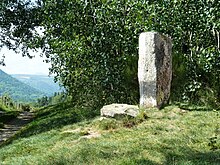Saint-Nectaire (Puy-de-Dôme)
| Saint-Nectaire | ||
|---|---|---|

|
|
|
| region | Auvergne-Rhône-Alpes | |
| Department | Puy-de-Dôme | |
| Arrondissement | Issoire | |
| Canton | Le Sancy | |
| Community association | Massif du Sancy | |
| Coordinates | 45 ° 35 ′ N , 3 ° 0 ′ E | |
| height | 609–1,011 m | |
| surface | 33.26 km 2 | |
| Residents | 741 (January 1, 2017) | |
| Population density | 22 inhabitants / km 2 | |
| Post Code | 63710 | |
| INSEE code | 63380 | |
 Entrance |
||
Saint-Nectaire is a French municipality with 741 inhabitants (at January 1, 2017) in the department of Puy-de-Dôme in the region Auvergne Rhône-Alpes . It is known nationwide for three things:
- the Romanesque former priory church of Notre-Dame-du-Mont-Cornadore de Saint-Nectaire
- the Saint-Nectaire cheese, named after the town , which is produced here and in the surrounding area.
- it has thermal springs with spa facilities in nearby La Bourboule and on Monts Dore . The springs were used by the Fontaines pétrifiantes de Saint-Nectaire and their founders Jean Serre and Michel Papon from the first half of the 19th century to produce artificial fossils. For this purpose, molds are placed in the mineral water for at least one year, creating reliefs and incrustations ( sinter ) of all kinds.
geography
Saint-Nectaire is located in the eastern part of the Monts Dore massif , which in turn is part of the Massif Central . The city is divided into two parts, Saint-Nectaire-le-Haut with the Romanesque church on the southern slope of the valley and Saint-Nectaire-le-Bas with the thermal springs, down in the valley.
history

Dolmens and menhirs
Saint-Nectaire still has a lot of evidence of the Neolithic era, for example five dolmens and two menhirs can be seen in the vicinity of the village. Immediately on Mont Cornadore , not far from the later Christian church, there is a large dolmen. Here, too, the not so rare close proximity between the early cult sites and a Christian church (such as the cathedral of Le Mans or in Langenstein ) is striking .
Antiquity and Migration Period
Neolithic stone setting later often became religious centers of Celtic peoples , especially those of this extraordinary size. One can only guess that for this dolmen. The area of the Basse Auvergne was in any case settled by the Gallic tribe of the Arverner , whose name can be found in the region . After Caesar had defeated the Gauls under Vercingetorix in Alesia ( Burgundy ) in 52 BC , the Romans also occupied the land of the averna civitas (from the 1st to the 3rd century), which became a Gallic province . One speaks of the Gallo-Roman era, for which the use of the thermal springs in the region has been proven.
At the time of the Great Migration (4th to 6th centuries), West Goths , Franks , Saracens and Vikings repeatedly attacked the former Gallo-Roman centers. At that time there was still no significant settlement in the area that would later become Saint-Nectaire that the migrating peoples could have been interested in.
Attractions
The Romanesque former priory church of Saint-Nectaire
The former priory church of Saint-Nectaire is built in the variant of the Romanesque church style typical of the Auvergne. It is one of the five main Romanesque churches in the Puy-de-Dôme department , together with the Notre-Dame du Port collegiate church in Clermont-Ferrand , the Notre-Dame basilica in Orcival , the Saint-Austremoine monastery church in Issoire and the church of Saint- Saturnin . What is particularly striking and unique in the Romanesque churches of the Auvergne is the heightening of the transept, which is referred to as a massif barlong or Auvergne cross bar .
Personalities
- Jean-Charles de La Ferté (1685–1771), Marquis of Saint-Nectaire, Count of Saint-Victour , Marshal of France
literature
- Ulrich Rosenbaum: Auvergne and Massif Central. Voyages of discovery from Clermont-Ferrand over the volcanoes and gorges of the Massif Central to the Cevennes National Park (= DuMont documents. DuMont art travel guide. ). 7th edition. DuMont, Cologne 1989, ISBN 3-7701-1111-7 .
- Thorsten Droste: Romanesque Art in France. A travel companion to all the important Romanesque churches and monasteries (= DuMont documents. DuMont art travel guide. ). 2nd Edition. DuMont, Cologne 1992, ISBN 3-7701-2009-4 .
Web links
Individual evidence
- ↑ Philippe Gloaguen, et al .: Le Routard - Le guide de la visite d'entreprise . No. 79/0425/0 . Hachette Livre, Vanves 2016, ISBN 978-2-01-323703-1 , pp. 236 f .
- ↑ Fontaines Pétrifiantes de Saint-Nectaire. Retrieved November 14, 2019 (French).
- ^ Ulrich Rosenbaum: Auvergne and Massif Central. Voyages of discovery from Clermont-Ferrand over the volcanoes and gorges of the Massif Central to the Cevennes National Park (= DuMont documents. DuMont art travel guide ). 4th edition. DuMont Cologne 1986, ISBN 3-7701-1111-7 , p. 89.


